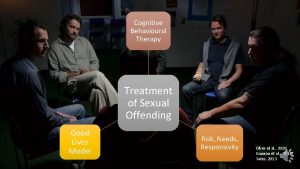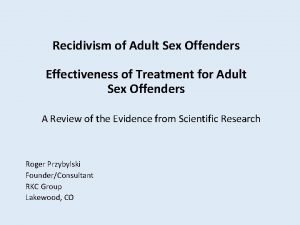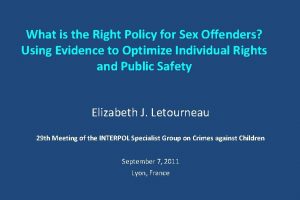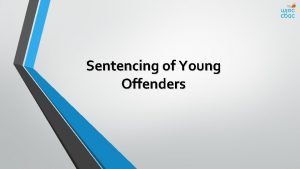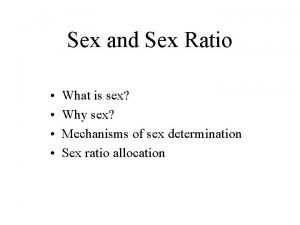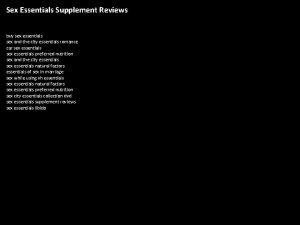What is the Right Policy for Sex Offenders







































- Slides: 39

What is the Right Policy for Sex Offenders? Using Evidence to Optimize Individual Rights and Public Safety Elizabeth J. Letourneau 29 th Meeting of the INTERPOL Specialist Group on Crimes against Children September 7, 2011 Lyon, France

Overview Presentation 1: Adult Sex Offender Registration and Notification Part I: A History of U. S. Sex Crime Legislation Part II: Review of the Research Part III: Policy Recommendations Presentation 2: Juvenile Sex Offender Registration and Notification Part IV: Review of the Research Part V: Policy Recommendations

Three Waves of US Sex Crime Legislation Wave II “Sexual Psychopaths” Wave I “Sexual Perverts” Wave III “Sexually Violent Predators” 1880 1890 1900 1910 1920 1930 1940 1950 1960 1970 1980 1990 2000 2010 Forced sterilization and indefinite incarceration (state-level policies) Indefinite treatment (statelevel policies) Sex offender registration and public notification (federal-level policies) Indefinite civil commitment (state-level policies)

The Rise of (Modern) Sex Crime Legislation Laws targeting sexually violent predators (re)emerged in the 1990’s due largely to activism by parents of victims of a few horrific sex crime cases Jacob Wetterling Megan Kanka Adam Walsh

Culmination of Modern Sex Crime Legislation: The Adam Walsh Child Protection and Safety Act � � Requires long-term sex offender registration and notification (SORN) for most types of sex crimes Prohibits use of actuarial risk assessment for modifying SORN requirements Requires frequent registration of more extensive personal information Requires lifetime registration for some juveniles

PART II RESEARCH ON POLICY EFFECTS These policies were designed to deter sexual offending � Do policies based on a few extraordinary cases work? � Could policies make things worse, despite good intentions?

The US Public Strongly Supports Registration/Notification Citizen surveys document near universal support for registration and notification People report that SORN policies: � � � Make people feel safer Make people more likely to report suspicious behavior Make offenders behave better Most people say they would support SORN policies even if there is no scientific evidence showing that they reduce sexual abuse Slide credits: Kurt Bumby, Jill Levenson

Offenders Subjected to Notification Often Suffer Severe Social Harm Registered offender victim of arson Surveys of offenders and their families document possibly risk-enhancing effects: � Loss of social supports, isolation � Harassment of partners and children � Loss of housing and employment � Verbal/physical harassment Sex offenders’ killer found names on state site So what? Slide credit: Kurt Bumby

SORN Policies Do Not Deter Sexual or Violent Recidivism NO DIFFERENCES REDUCED RECIDIVISM INCREASED RECIDIVISM Letourneau et al. , 2010 Letourneau et al. 2009* Caldwell & Dickenson, 2009* Veysey, Zgoba, & Dalessandro, 2009 Zgoba et al. , 2009 Caldwell, Ziemke, & Vitacco, 2008* Sandler, Freeman & Socia, 2008 Vásquez, Madden & Walker, 2008 Letourneau & Armstrong, 2008* Sandler & Freeman, 2010 Zevitz, 2006 Prescott & Rockoff, 2008** Letourneau et al. , 2009* Adkins et al. , 2000 Duwe & Donney, 2008 Letourneau & Armstrong, 2008* Schram & Milloy, 1995 WSIPP, 2005 Prescott & Rockoff, 2008** * Denotes juvenile studies; ** Prescott & Rockoff found different effects for registration vs. notification

South Carolina Research Program We have examined policy effects on four outcomes: 1. 2. 3. 4. General deterrence Sexual and nonsexual recidivism Plea bargain and conviction rates Relationship between “failure to register” and recidivism This research was supported by a grant from the National Institute of Justice (Award number: 2006 -WT-BX-0001) Dr. Jill Levenson served as co-investigator; Mr. Kevin Armstrong and Drs. Dipankar Bandyopadhyay and Debajyoti Sinha conducted the analyses

South Carolina’s SORN Policy South Carolina’s SORN policy is similar to federal SORN policy requirements are based solely on conviction offense � No risk assessment is used � Registration and notification are for life � Outcomes from our research might forecast the national effects of federal SORN policy

Policy Effects on General Deterrence This study addressed the question “did first-time sex crime arrests decline after SORN was implemented? ” using data from 19, 060 sex crimes Results indicated that sex crime arrests declined significantly following initial implementation of SC’s SORN policy � There was a 10% decline after policy initiation � About 3 sex crimes were averted per month � � There was no additional effect for online notification There was no similar effect for assault or robbery arrests Publication reference: Letourneau, E. J. , Levenson, J. S. , Bandyopadhyay, D. , Armstrong, K. S. , & Sinha, D. (2010). Effects of South Carolina’s Sex Offender Registration and Notification Policy on Deterrence of Adult Sex Crimes. Criminal Justice and Behavior, 37, 537 -552.

Policy Effects on Recidivism This study addressed the question “did SORN reduce sexual, violent, or nonviolent recidivism by convicted sex offenders? ” Sample: � 6, 064 men convicted of one or more sex crimes � 53% were registered at some point during follow-up Follow-up: � M = 8. 4 yrs (SD = 3. 9) Publication reference: Letourneau, E. J. , Levenson, J. S. , Bandyopadhyay, D. , Sinha, D. , & Armstrong, K. S. (in press). Effects of South Carolina’s Sex Offender Registration and Notification Policy on Adult Recidivism. Criminal Justice Policy Review.

Policy Effects on Recidivism SORN had no effect on new sexual offenses � � 8% had new sexual offense charges and 5% had new convictions Registration status was not a significant predictor of new charges or convictions SORN had no effect on new violent or nonviolent offenses � � 9% had new violent offenses and 35% had new nonviolent offenses All predictor variables (such as age at offense, prior offenses) except registration status predicted violent and nonviolent recidivism

Policy Effects on Plea Bargains and Convictions This study addressed the questions “did the likelihood of plea bargains change after SORN” and “did the likelihood of guilty findings change after SORN” � Data from 15, 953 defendants charged with 17, 467 sex offenses from 1990 -2005 were used in analyses Letourneau, E. J. , Levenson, J. S. , Bandyopadhyay, D. , Armstrong, K. , S. , & Sinha, D. , (2010). The effects of sex offender registration and notification on judicial decisions. Criminal Justice Review, 35, 295 -317.

Policy Effects on Plea Bargains SORN was associated with increased plea bargains � � The likelihood of plea bargaining from sex to nonsex offense charges doubled over time � 10% of cases pleaded during pre-SORN years � 15% of cases pleaded following initial SORN implementation � 20% of cases pleaded following implementation of online notification Defendants charged with “registry-eligible” sex offenses were most likely to plead to nonsex offense charges

Policy Effects on Guilty Findings Online notification was associated with decreased likelihood of guilty findings � Plea bargains increased over time, which initially increased the likelihood of guilty findings � However, following enactment of online notification, the likelihood of guilty findings declined significantly � 48% of defendants found guilty during pre-SORN years � 54% of defendants found guilty following initial SORN implementation � 45% of defendants found guilty following implementation of online notification

Relationship Between Failure to Register and Recidivism The 2006 federal Adam Walsh Act made registration more complex; as a result, failure to register (FTR) is now the most common reoffense event for registered sex offenders At the same time the AWA elevated FTR to felony status with a minimum 1 -year incarceration period for first offenses The hypothesis was that sex offenders who fail to register are hiding from the law in order to commit new sex offenses This study addressed the question “are offenders who fail to register more likely to commit new sex crimes? ” Publication reference: Levenson, J. S. , Letourneau, E. J. , Armstrong, K. S. , & Zgoba, K. M. (2010). Failure to register as a sex offender: Is it associated with recidivism? Justice Quarterly, 27, 305 -331.

Non-FTR: n = 2, 700 FTR: n = 270

Non-FTR

Summary of Research Findings SORN is associated with modest declines in first-time sex crimes SORN does not reduce sexual, violent, or nonviolent recidivism SORN encourages plea bargains from sex to nonsex offenses Online notification discourages guilty findings for sex offenses FTR does not predict sexual recidivism FTR does predict general recidivism and likely reflects general criminality, defiance, low IQ

Conclusions South Carolina’s SORN policy relies entirely on conviction offense, targets a broad range of sexual offenses, requires lifetime registration and online notification for all adult registrants and severely penalizes FTR offenses This policy overwhelmingly targets low risk offenders unlikely to reoffend Substantial resources are to initial and ongoing registration and incarceration for FTR with little reduction in sexual violence

Policy Recommendations 1. Public notification requirements should be eliminated 2. Registration requirements should be based on empirically validated risk assessment procedures and target only high risk offenders Duration of registration requirements should be curtailed to reflect decreased recidivism risk over time Graduated sanctions should apply to FTR 3. 4. Countries that have not enacted registration and notification policies should avoid doing so or should delay policy implementation until research conclusively demonstrates some public benefit

Juvenile Registration and Notification Policies are Ineffective Elizabeth J. Letourneau 29 th Meeting of the INTERPOL Specialist Group on Crimes against Children September 7, 2011 Lyon, France

Overview I. III. IV. Comparison of South Carolina and Federal SORN policies Brief description of SC registered youth Summary of studies examining SC’s policy on recidivism, deterrence, and juvenile case processing outcomes Policy recommendations The research presented today was supported by the Centers for Disease Control and Prevention (R 49 CE 00567) and the National Science Foundation (SES 0455124) Mr. Kevin Armstrong and Drs. Dipankar Bandyopadhyay and Debajyoti Sinha conducted the analyses

Comparison of SORNA and SC Policies FEDERAL SORNA POLICY � Offense based � Includes no risk assessment process � Lower age limit of 14 � Requires lifetime registration for juvenile registrants � No longer requires targeted or online notification SC Policy � Offense based � Includes no risk assessment process � No lower age limit � Requires lifetime registration for juvenile registrants � Subjects all registered youth to targeted notification and some youth to online notification

Description of SC Registered Youth From January 1995 to July 2006: q 12% of registered offenders were < 17 years at offense q Of these youth: § § § Mean age at adjudication was 15 years (SD = 1. 6 years); youngest registrant was 8 years old at adjudication Mean age at initial registration was 21 years (SD = 7 years); youngest registrant was 10 years old at initial registration 98% of registrants were male 55% of registrants were African American; 45% White 15% were required to register for noncontact offenses

Study 1: Policy Effects on Sexual Recidivism This study addressed the question “does SORN reduce sexual, violent, or nonviolent recidivism? ” § Recidivism analyses were informed by data on 1, 275 male youth adjudicated for sex offenses from 1990 -2004 § Mean follow-up: 9 years § Outcomes included new charges and new convictions identified in juvenile and adult justice records Publication reference: Letourneau, E. J. , Bandyopadhyay, D. , Sinha, D. , & Armstrong, K. S. (2009). The influence of sex offender registration on juvenile sexual recidivism. Criminal Justice Policy Review, 20, 136 -153.

Juveniles Far More Likely to Reoffend With Nonsexual, Nonviolent Crimes Sex recidivism Violent recidivism Non-violent recidivism

No Policy Effect on Reducing Recidivism SORN was not associated with reduced sexual recidivism o 7. 5% youth had new sex crime charges; 2. 5% youth had new sex crime convictions o Registration status did not predict new sex offense charges or convictions o Registered youth were more likely to sustain new nonviolent offense charges, but not convictions Thus, SORN failed to reduce serious recidivism and increased the risk of unnecessary low-level charges

Study 2: Policy Effects on General Deterrence This study addressed the question “did first-time sex crime arrests decline after SORN implementation? ” Trend analyses were informed by data on 26, 574 male youth charged with 28, 288 crimes from 1990 -2004 N = 3, 148 youth charged with sex crimes § N = 23, 046 youth charged with assault crimes § N = 2, 094 youth charged with robbery crimes § Publication reference: Letourneau, E. J. , Bandyopadhyay, D. , Armstrong, & Sinha, D. (2010). Do Sex Offender Registration and Notification Requirements Deter Juvenile Sex Crimes? Criminal Justice & Behavior, 37, 553 -569.

No General Deterrence Results indicated no significant reductions in rates of first-time sex crimes following initial policy enactment or online notification Upper CI Raw data Lower CI Initial enactment Online notification

Study 3: Policy Effects on Prosecution of Juvenile Sex Crime Cases This study addressed the question “did SORN influence prosecutors to dismiss/divert juvenile sex crime cases? ” Analyses were informed by data on violent offense cases from 1990 -2004: � N = 5, 503 juvenile sex offense charges � N = 14, 095 juvenile assault offense charges � N = 2, 942 juvenile robbery offense charges Publication reference: Letourneau, E. J. , Bandyopadhyay, D. , Sinha, D. , & Armstrong, K. S. (2009 a). The effects of sex offender registration policies on juvenile justice decision making. Sexual Abuse: A Journal of Research and Treatment, 21, 149 -165.

SORN Associated with Reduced Likelihood of Prosecution Results indicated a 41% reduction in the odds of prosecutors moving forward on juvenile sex crime cases following policy enactment with no similar changes for other types of violent crime

Study 4: Policy Effects on Plea Bargains 30% 33 20% 24 10% lic po in On l po al iti e lic y icy 0% y 12 In No similar effects for assault or robbery 40% ol Plea bargains for juvenile sex offense cases nearly tripled from pre-registration through online-notification time periods 50% Pr ep This study addressed the question “does SORN encourage plea bargains from sex to nonsex offense charges? ” and was informed by data from: § 2, 991 sex offense cases § 16, 091 assault offense cases § 2, 036 robbery offense cases Publication reference: Letourneau, E. J. , Armstrong, K. S. , Bandyopadhyay, & D. , Sinha, D. (in press). Sexual Abuse: A Journal of Research and Treatment.

Summary of Policy Effects South Carolina’s SORN policy 1. 2. 3. 4. 5. Overwhelming targets low risk youth Fails to reduce first-time sex crimes Fails to reduce sexual or violent recidivism Increases youth risk of unnecessary low-level charges Deters prosecution of juvenile sex crime cases and encourages plea bargains when cases are prosecuted

SC’s Policy Might Increase Risk The changes in case processing might increase the risk of community harm: � Youth whose cases are dismissed or reduced to nonsex offenses do not receive sex offender-specific supervision and treatment To date, no research has supported any positive effects of juvenile registration or notification policies

POLICY RECOMMENDATIONS Eliminate all notification requirements for juveniles Eliminate all registration requirements for juveniles If elimination of registration requirements is unattainable: 1. 2. 3. § § § restrict registration requirements to highest risk youth as identified by best available procedures significantly reduce duration of registration; for example, link duration to formal supervision eliminate all collateral consequences of registration (e. g. , school & residency restrictions, GPS monitoring) Countries that have not enacted juvenile registration or notification policies should avoid doing so

Speaker Contact Information Elizabeth J. Letourneau, Ph. D. Department of Mental Health Bloomberg School of Public Health Johns Hopkins University 624 North Broadway Hampton House/Room 831 Baltimore, Maryland 21204 410 -955 -9913 (office phone) eletourn@jhsph. edu
 Sex sex sex
Sex sex sex Sex sex sex
Sex sex sex Kurt bumby
Kurt bumby Secondary sexual characters
Secondary sexual characters Greenhouse sex
Greenhouse sex Cognitive behavioral therapy for sex offenders
Cognitive behavioral therapy for sex offenders Cognitive behavioral therapy for sex offenders
Cognitive behavioral therapy for sex offenders Right product right place right time right price
Right product right place right time right price Family time
Family time The right man on the right place at the right time
The right man on the right place at the right time Once a sex offender always a sex offender
Once a sex offender always a sex offender Sex
Sex Sex rat
Sex rat Sex determination and sex linkage
Sex determination and sex linkage Youthful offenders act 1854
Youthful offenders act 1854 Young offenders act 1984
Young offenders act 1984 Custodial institution
Custodial institution According to choice theorists, offenders:
According to choice theorists, offenders: Juvenile delinquency graphic organizer
Juvenile delinquency graphic organizer Left left right right go go go
Left left right right go go go Left right go go go
Left right go go go You put your left foot in
You put your left foot in Rådet för byggkompetens
Rådet för byggkompetens Arkimedes princip formel
Arkimedes princip formel Elektronik för barn
Elektronik för barn Kassaregister ideell förening
Kassaregister ideell förening Densitet vatten
Densitet vatten Tack för att ni har lyssnat
Tack för att ni har lyssnat Borra hål för knoppar
Borra hål för knoppar Smärtskolan kunskap för livet
Smärtskolan kunskap för livet Teckenspråk minoritetsspråk argument
Teckenspråk minoritetsspråk argument Mjälthilus
Mjälthilus Frgar
Frgar Mindre än tecken
Mindre än tecken Delegerande ledarskap
Delegerande ledarskap Indikation för kejsarsnitt på moderns önskan
Indikation för kejsarsnitt på moderns önskan Toppslätskivling dos
Toppslätskivling dos Returpilarna
Returpilarna Redogör för vad psykologi är
Redogör för vad psykologi är Mat för unga idrottare
Mat för unga idrottare





